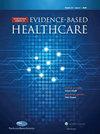过度用药:医学新现象还是由来已久的现象?
Q3 Medicine
International Journal of Evidence-Based Healthcare
Pub Date : 2022-01-24
DOI:10.17267/2675-021xevidence.2022.e3792
引用次数: 0
摘要
引言:提到过度使用往往意味着这是一个最近的现象,好像非理性是由技术进步和新程序的发展带来的。然而,有可能自古以来,医生就有同样的认知偏见,也会进行不适当和过度的手术。这就提出了一个问题,即当代的过度使用问题是一种现代现象,还是从几千年的医学传统中继承下来的。目的:通过总结医学史上有关药物滥用的医学文献,推断出这一问题的答案。方法:医疗过度使用被定义为无效的、低价值的程序,其特征是过度使用对患者造成弊大于利的高概率方法。它考察了医学文献的历史,以批判性的眼光看待可能被定性为有害的、无用的或过度使用诊断和治疗方法的程序。结果:这一分析揭示的证据表明,这些程序已经发生在许多历史时期。研究表明,目前不适当医疗程序的患病率在美国高达29%,在世界各地的一些个别服务中,这一比例高达80%。缺乏可靠的数据阻碍了对过去十年前过度使用流行程度的准确分析。结论:无论技术进步如何,过度使用从一开始就渗透到医疗实践中,而不是最近的现象,并且可能是人类固有的。本文章由计算机程序翻译,如有差异,请以英文原文为准。
Overuse: medical novelty or age-old phenomenon?
INTRODUCTION: Mentions of overuse tend to imply it is a recent phenomenon as if irrationality was brought about by technological advances and the development of new procedures. However, it is possible that physicians have been prone to the same cognitive biases since antiquity, also performing inappropriate and excessive procedures. This raises the question of whether the contemporary issue of overuse is a modern phenomenon or inherited from a multi-millennial medical tradition. OBJECTIVE: To infer an answer to this question by summarizing the medical literature about overuse throughout the history of medicine. METHODS: Medical overuse is defined as futile, low-value procedures characterized by excessive use of methods with a high probability of causing more harm than good to patients. It examines the history of medical literature, with a critical look at procedures that might be characterized as harmful, futile, or with excessive use of diagnostic and therapeutic methods. RESULTS: This analysis revealed evidence that such procedures have been taking place throughout many periods of history. Studies have shown that the current prevalence of inappropriate medical procedures can be as high as 29% in the United States and 80% of cases for some individual services around the world. Lack of reliable data thwarts accurate analysis of the prevalence of overuse before the last decade. CONCLUSIONS: Instead of a recent phenomenon, overuse has permeated medical practice from its beginnings until today, regardless of technological advances, and is possibly inherent to the human species.
求助全文
通过发布文献求助,成功后即可免费获取论文全文。
去求助
来源期刊

International Journal of Evidence-Based Healthcare
Medicine-Health Policy
CiteScore
1.80
自引率
0.00%
发文量
39
期刊介绍:
The International Journal of Evidence-Based Healthcare is the official journal of the Joanna Briggs Institute. It is a fully refereed journal that publishes manuscripts relating to evidence-based medicine and evidence-based practice. It publishes papers containing reliable evidence to assist health professionals in their evaluation and decision-making, and to inform health professionals, students and researchers of outcomes, debates and developments in evidence-based medicine and healthcare.
The journal provides a unique home for publication of systematic reviews (quantitative, qualitative, mixed methods, economic, scoping and prevalence) and implementation projects including the synthesis, transfer and utilisation of evidence in clinical practice. Original scholarly work relating to the synthesis (translation science), transfer (distribution) and utilization (implementation science and evaluation) of evidence to inform multidisciplinary healthcare practice is considered for publication. The journal also publishes original scholarly commentary pieces relating to the generation and synthesis of evidence for practice and quality improvement, the use and evaluation of evidence in practice, and the process of conducting systematic reviews (methodology) which covers quantitative, qualitative, mixed methods, economic, scoping and prevalence methods. In addition, the journal’s content includes implementation projects including the transfer and utilisation of evidence in clinical practice as well as providing a forum for the debate of issues surrounding evidence-based healthcare.
 求助内容:
求助内容: 应助结果提醒方式:
应助结果提醒方式:


